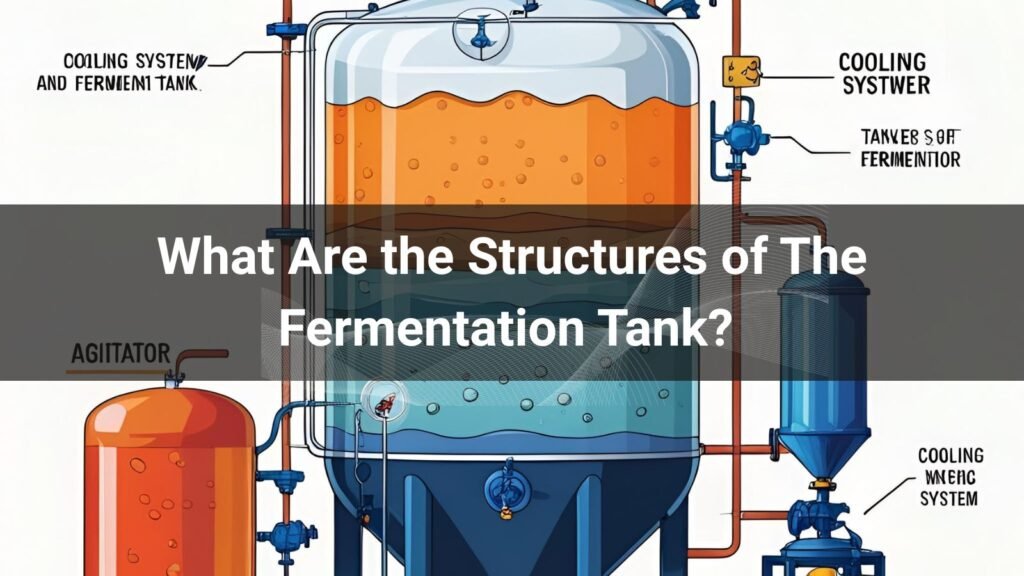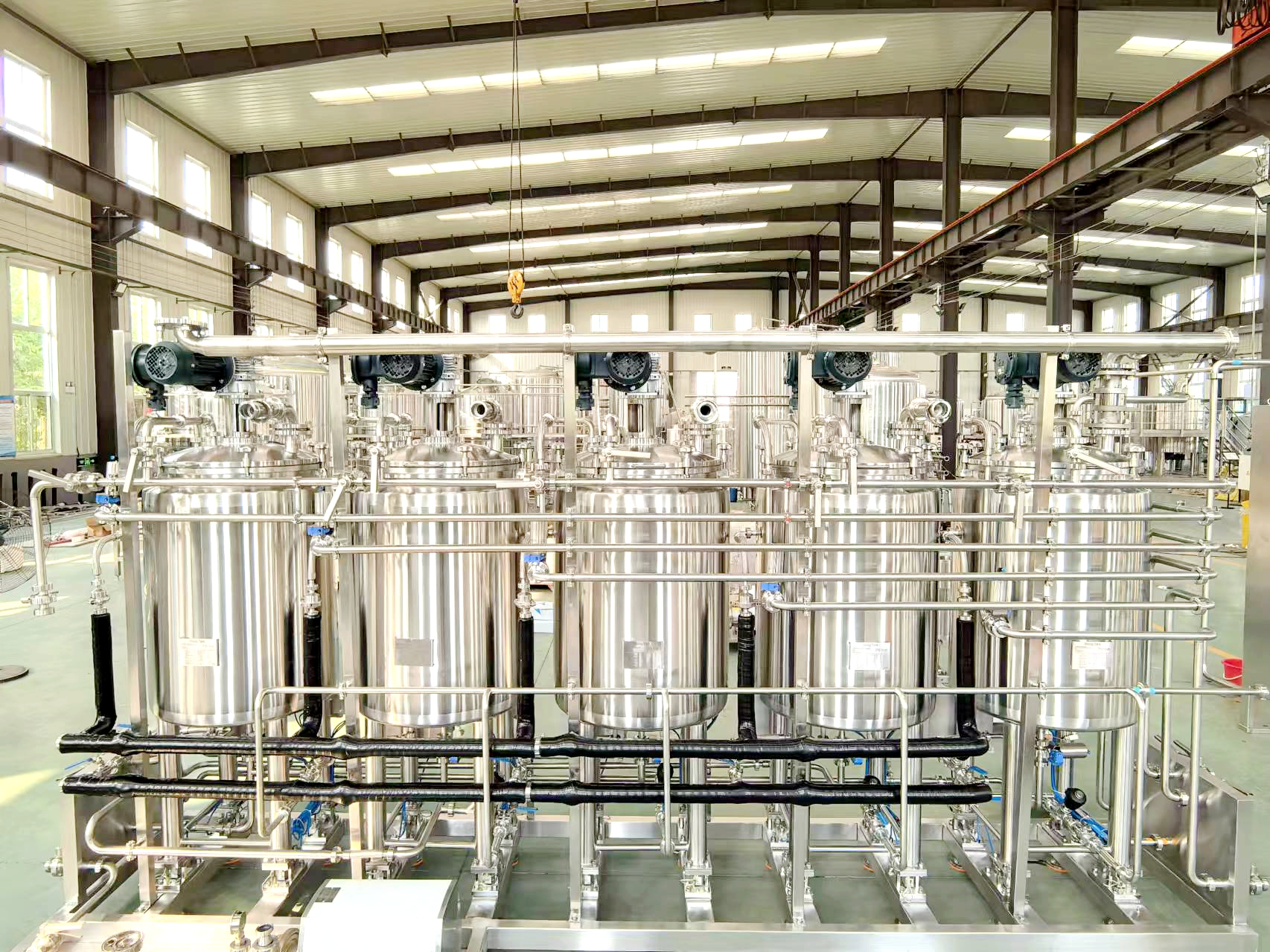
Understanding the structures of fermentation tanks is crucial for anyone involved in wine, cider, or beer
production. Fermentation tanks are sophisticated vessels engineered with specific components that ensure optimal
fermentation conditions, maintain product quality, and facilitate efficient operation. This comprehensive guide
explores the essential structural elements, materials, design features, and technical specifications that make
fermentation tanks effective for beverage production across various scales.
Table of Contents
Basic Structure Components
The fundamental structure of a fermentation tank consists of several critical components that work together to
create an optimal environment for fermentation processes. Understanding these basic elements is essential for
selecting the right equipment for your specific application.
Primary Structural Elements
Every fermentation tank incorporates specific structural components designed to maintain integrity under pressure
while providing functionality for the fermentation process. The head plate forms the top of the
tank and is typically constructed from 3mm SS304 stainless steel to withstand internal pressure variations. The
body of the tank, also made from 3mm SS304 stainless steel, provides the main containment volume
and must be engineered to handle the stress of liquid contents and fermentation gases.
| Component | Material | Thickness | Primary Function |
|---|---|---|---|
| Head Plate | SS304 Stainless Steel | 3mm | Top closure and pressure containment |
| Body Shell | SS304 Stainless Steel | 3mm | Main containment vessel |
| Bottom Section | SS304 Stainless Steel | 3-4mm | Sediment collection and drainage |
| Support Structure | SS304 Stainless Steel | Variable | Weight distribution and stability |
The bottom section of fermentation tanks varies significantly depending on the intended application.
Conical bottom tanks feature a 60-degree conical bottom that allows yeast and sediment to settle
naturally, facilitating easy removal without disturbing the liquid above. This design is particularly beneficial for
wine and cider production where sediment separation is crucial for product clarity.
Materials and Construction Methods
The choice of materials and construction methods directly impacts the performance, longevity, and safety of
fermentation tanks. Modern fermentation vessels utilize advanced materials and sophisticated welding techniques to
ensure optimal results.
Stainless Steel Specifications
Food-grade 304 stainless steel remains the gold standard for fermentation tank construction due to its exceptional
properties. This material offers excellent corrosion resistance, ease of cleaning, and neutral flavor impact on the
fermentation process. The selection of SS304 ensures that tanks can withstand the acidic conditions common in wine
and cider fermentation while maintaining structural integrity over many years of use.
Professional manufacturers like Shandong Chenma Machinery Co., Ltd. employ advanced construction
techniques to maximize the performance of their fermentation equipment. Located in Shandong Province, Chenma
utilizes a combination of automated robotic welding and hand-crafted welds executed through tungsten inert gas (TIG)
processes. This sophisticated approach results in joints that are exceptionally strong, smooth, and sanitary.
Welding and Surface Treatment
The welding process represents a critical aspect of fermentation tank construction. 100% TIG
welding ensures consistent, high-quality joints that can withstand the stresses of fermentation while
maintaining sanitary conditions. Following welding, tanks undergo polishing and passivation treatment on all metal
surfaces, creating a smooth finish that resists bacterial growth and facilitates thorough cleaning.
Surface treatment extends beyond aesthetics to functional necessity. The polished interior surfaces prevent the
accumulation of residues that could harbor contaminants, while the passivated surface develops a protective oxide
layer that enhances corrosion resistance. This attention to surface quality directly impacts the longevity of the
equipment and the quality of the final product.
Tank Shapes and Configurations
Fermentation tank shapes have evolved to optimize different aspects of the fermentation process, with each
configuration offering specific advantages for particular applications. Understanding these variations helps in
selecting the most appropriate design for specific production needs.
Cylindrical Tanks
Cylindrical fermentation tanks represent the most common configuration for large-scale production. These wine fermentation tanks provide excellent structural
strength and efficient use of space while offering uniform pressure distribution throughout the vessel. The
cylindrical shape facilitates even temperature distribution and allows for efficient cooling system integration.
Conical Bottom Designs
The incorporation of conical bottoms in fermentation tanks serves multiple functional purposes. The angled bottom
promotes natural sediment settlement, concentrating yeast and other particles at the lowest point for easy removal.
This design feature is particularly valuable in wine production where sediment management directly affects product
quality and clarity.
Variable Capacity Options
Modern fermentation facilities often require flexibility in batch sizes, leading to the development of variable capacity wine tanks. These innovative
designs allow operators to adjust the effective volume of the tank to match production requirements, optimizing
space utilization and reducing waste from partially filled vessels.
| Tank Shape | Best Application | Key Advantages | Capacity Range |
|---|---|---|---|
| Cylindrical | Large-scale production | Structural strength, space efficiency | 1,000L – 50,000L+ |
| Conical Bottom | Wine and cider | Sediment management, easy cleaning | 500L – 20,000L |
| Variable Capacity | Flexible production | Batch size adaptability | 1,000L – 10,000L |
| Square/Rectangular | Space-constrained facilities | Maximum space utilization | 500L – 5,000L |
Cooling Systems and Temperature Control
Temperature control represents one of the most critical aspects of fermentation tank design, as proper temperature
management directly influences fermentation kinetics, flavor development, and product quality. Modern fermentation
tanks incorporate sophisticated cooling systems to maintain optimal conditions throughout the fermentation process.
Dimple Jacket Systems
The dimple jacket cooling system consists of an exterior shell constructed from 1.5mm to 2mm SS304
stainless steel that creates a space for coolant circulation around the tank body. This design provides efficient
heat transfer while maintaining the structural integrity of the primary vessel. The dimple pattern increases surface
area contact between the coolant and the tank wall, enhancing cooling efficiency.
Spiral Cooling Channels
An alternative to dimple jackets, spiral cooling channels wind around the exterior of the tank in a helical
pattern. This configuration offers excellent temperature uniformity and can be particularly effective for smaller
tanks where precise temperature control is essential. The spiral design ensures that coolant contacts the entire
surface area of the tank systematically.
Insulation Systems
Professional-grade fermentation tanks incorporate comprehensive insulation systems to maintain temperature
stability and improve energy efficiency. Polyurethane insulation injected to an 80mm thickness
provides excellent thermal properties while protecting the cooling system from ambient temperature fluctuations.
This insulation significantly reduces energy consumption and helps maintain consistent fermentation conditions.
Access Points and Maintenance Features

Proper access points and maintenance features are essential for the practical operation of fermentation tanks.
These elements enable effective cleaning, inspection, sampling, and product transfer while maintaining sanitary
conditions throughout the process.
Manways and Access Ports
Fermentation tanks incorporate multiple access points designed for specific functions. The top manhole
cover provides access for tank interior inspection and cleaning, while side rectangle
manways offer convenient entry points for maintenance activities. These access points feature knobs for
easy opening and include gasket systems to ensure proper sealing when closed.
Outlet Systems
Professional fermentation tanks feature multiple outlet systems to facilitate different operational requirements.
The primary wine outlet allows for product transfer at the completion of fermentation, while the
drain outlet enables complete tank emptying for cleaning and maintenance. Sample
valves permit quality control testing without compromising the main product volume.
CIP (Clean-In-Place) Systems
Modern fermentation tanks integrate sophisticated CIP systems that combine rotating spray balls with pressure
gauges, pressure adjusting apparatus, arms, and valves. This system ensures thorough cleaning without requiring tank
disassembly, maintaining sanitary conditions while reducing downtime between batches.
Specialized Features for Different Applications
Different fermentation applications require specific features tailored to the unique requirements of each process.
Understanding these specialized components helps in selecting equipment optimized for particular production goals.
Wine-Specific Features
Wine fermentation tanks often incorporate features designed to enhance the specific requirements of wine
production. These may include punch-down devices for red wine cap management, must
pumps for grape processing, and specialized lees stirring systems to enhance flavor
extraction during aging processes.
Cider Production Adaptations
For cider fermentation, tanks may feature specialized ports for
fruit addition, enhanced sediment management systems for apple pulp removal, and temperature control systems
optimized for the specific requirements of apple fermentation. The design considerations for cider tanks often emphasize easy cleaning due to the higher fiber
content in apple-based fermentations.
Carbonation and Pressure Systems
Some fermentation tanks incorporate systems for natural or forced carbonation, including carb
stones installed at the tank bottom for efficient CO2 dissolution. Pressure regulation systems allow for
controlled fermentation environments and can facilitate the production of sparkling beverages through secondary
fermentation processes.
Quality Standards and Certifications
Professional fermentation tank manufacturers adhere to strict quality standards and maintain relevant
certifications to ensure their equipment meets industry requirements. These standards govern materials, construction
methods, safety features, and performance specifications.
International Certifications
Leading manufacturers like Shandong Chenma Machinery maintain comprehensive certification programs including
ISO9001-2005 quality system certification, ISO14001-2015 environmental management system
certification, and OHSAS18001-2007 occupational health management system certification.
Additionally, EU CE certification ensures compliance with European safety and quality standards.
Material Standards
Fermentation tanks must utilize materials that meet food-grade specifications and maintain their properties under
fermentation conditions. SS304 stainless steel must conform to relevant ASTM standards for chemical composition,
mechanical properties, and corrosion resistance. Surface finish specifications ensure that interior surfaces meet
sanitary requirements for food and beverage production.
Selection Considerations for Different Industries
Selecting the appropriate fermentation tank structure requires careful consideration of multiple factors including
production volume, product type, available space, and operational requirements. Each industry presents unique
challenges that influence design priorities.
Capacity Planning
Production capacity requirements directly influence tank size selection and structural specifications. Small craft
operations may benefit from tanks ranging from 1BBL to moderate commercial sizes, while large-scale production
facilities require vessels capable of handling thousands of liters. The scalability of operations should be
considered to ensure that initial equipment investments can accommodate future growth.
Space Optimization
Facility layout considerations significantly impact tank shape and configuration selection. Cylindrical tanks offer
excellent space efficiency for open floor areas, while square or rectangular tanks may provide better space
utilization in constrained environments. The height limitations of facilities may necessitate horizontal tank
configurations or the use of multiple smaller vessels.
Process Requirements
Different fermentation processes require specific structural features. Wine production benefits from conical bottom
tanks that facilitate sediment management, while beer production may require pressure-capable vessels for
conditioning processes. Chemical mixing applications
demand tanks with specialized agitation systems and material compatibility considerations.
Professional Support and Service
The selection of fermentation equipment should consider the availability of professional support and service.
Established manufacturers with comprehensive service networks can provide ongoing technical support, spare parts
availability, and maintenance services that ensure long-term operational success.
For those seeking professional guidance in fermentation tank selection and design, experienced manufacturers offer
consultation services to help match equipment specifications with operational requirements. Contact Shandong Chenma Machinery Co., Ltd. for expert advice
on fermentation tank structures and custom design solutions. Reach out via WhatsApp at
008618063421809 or email admin@sdchenma.com to discuss your specific fermentation equipment
needs.
Located in Pingyuan County Economic Development Zone, Dezhou City, Shandong Province, Chenma operates a 20,000 m² production facility equipped with
state-of-the-art machinery capable of producing even the most technically demanding designs. Their team of over 200
professionals specializes in manufacturing stainless steel tanks and processing equipment for the alcohol, food, and beverage industries.
Understanding fermentation tank structures enables informed decision-making when investing in equipment for wine,
cider, beer, or other fermented beverage production. The integration of proper materials, construction methods,
cooling systems, and specialized features ensures optimal fermentation conditions and long-term operational success.
By working with experienced manufacturers who maintain quality certifications and provide comprehensive support
services, producers can achieve their production goals while maintaining the highest standards of product quality
and safety.



